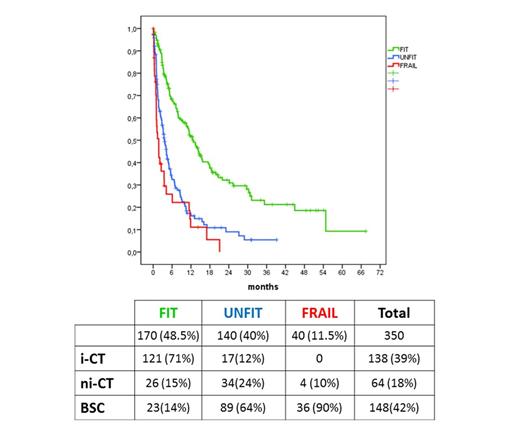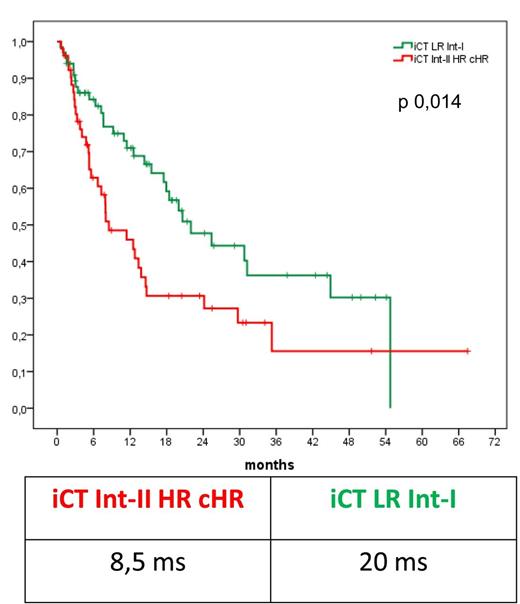Abstract
BACKGROUND: Median age of patients (pts) with acute myeloid leukemia (AML) ranges between 69 and 72 years in population-based series (SEER, 2012; Juliusson, 2009). The prognosis of elderly AML is exceedingly poor with overall 2-year survival of 10% (Juliusson, 2011). The use of intensive chemotherapy (i-CT) in elderly AML patients as opposed to non-intensive chemotherapy (ni-CT) or best supportive care (BSC) is still debated. Age is still the major driver of treatment choice but, in recent years, the role of pts' fitness and comorbidities was underscored. In 2013, a panel of experts proposed a set of objective criteria to define pts fit or unfit to conventional i-CT, ni-CT or BSC (Ferrara et al, Leukemia, 2013). Since such criteria derived from experts opinion, they need to be validated in the clinical setting to become an useful tool for therapy decision making.
AIMS: Fitness criteria were retrospectively applied to a population-based series of pts with AML (no M3), to evaluate a) their actual applicability; b) the concordance between fitness categorization of pts and the type of treatment they actually received; c) the outcome of pts according to fitness, to the prognostic stratification of European Leukemianet (ELN) and to the treatment received.
PATIENTS and METHODS. We evaluated 362 pts aged > 65 y, diagnosed at five Hematology Centres of the Hematological Network of Lombardy in Northern Italy (REL). Pts were diagnosed between January 2008 and May 2014. Their median age was 73 y (range 65-94 y). Their categorization according to fitness criteria was carried out retrospectively by the teams of physicians who had followed pts and through medical files. Pts were classified as fit to i-CT (FIT), unfit to i-CT (UNFIT), or unfit even to ni-CT (FRAIL). According to ELN prognostic criteria, applied in 201 de novo AML, pts were at low-risk (36 pts: 18%), of which 7 (3,4%) with CBF leukemia, intermediate-I (75 pts: 37%), intermediate-II (30 pts: 15%), or high risk (60 pts: 30%). Criteria were not applicable in 34 pts (14%) lacking karyotype or molecular data. The group of 127 pts (35%) with AML therapy-related or secondary to myeloid neoplasms was considered at high clinical risk (cHR). According to physicians decision, 139 pts (38.4%) had received i-CT, 65 pts (18%) ni-CT, including low-dose arac, azacytidine or experimental non-myelotoxic drugs, and 158 pts (43.6%) BSC.
RESULTS. Fitness criteria were not applicable in 12 pts (3%), because of insufficient data. Among 350 evaluable pts (97%), 170 (46.9%) were FIT, 140 (38.7%) were UNFIT, and 40 (11%) were FRAIL. Their median age was 69, 79 and 75 years, respectively (p <0.0001). Median overall survival (OS) of FIT, UNFIT and FRAIL pts was 12.5, 3.7 and 1.8 months, respectively (FIT vs others: P=0.0001, UNFIT vs FRAIL: p=0.049) (Figure 1). Overall concordance between fitness criteria and the treatment actually received by pts was 80% (71% in FIT, 88% in UNFIT and 90% in FRAIL pts). Median OS of pts receiving i-CT, ni-CT or BSC was 14.7, 14.2 and 4.2 months in FIT, (p<0.0001), 8.6, 8.9, 2 months in UNFIT (p<0.0001) (i-CT vs ni-CT: P:NS), respectively. Median OS inFRAIL pts receiving ni-CT (4 pts only) or BSC was 11.5 and 2 months, respectively (p:NS). Considering pts receiving i-CT, their outcome was significantly related both to ELN/clinical risk and to fitness. CR rate was 96.5% in LR, 66% in Int-I, 54% in Int-II, 46% in HR, 53% in cHR (p=0.0013). OS at 2y was 40% in LR/Int-I vs 25% in Int-II/HR/cHR pts (P=0.04). Median OS was 14.7 in FIT vs 8.6 months in UNFIT/FRAIL pts (P=0.022). By integrating ELN prognostic stratification with fitness, the use of i-CT obtained a significantly better median OS of 20 months in FIT pts at ELN LR/Int-I compared to 8,5 months in pts at Int-II/HR/cHR (p 0.014) (Figure 2).
CONCLUSIONS. The fitness criteria proposed were easily applicable even retrospectively and in a multicenter setting. Fitness was significantly related to patient's survival. In FIT and UNFIT pts outcome was similar with either i-CT or ni-CT, but these results need to be tested prospectively on larger cohorts. Integrating fitness with ELN criteria identifies a subgroup of FIT pts at low/Int-I ELN risk with a CR rate of 76.6% and a median OS of 20 months when treated with i-CT. Therefore fitness criteria seem to be a good tool to identify pts who can benefit from i-CT or ni-CT in alternative to BSC and to assist in the decision to use i-CT in elderly AML patients.
No relevant conflicts of interest to declare.
Author notes
Asterisk with author names denotes non-ASH members.



This feature is available to Subscribers Only
Sign In or Create an Account Close Modal